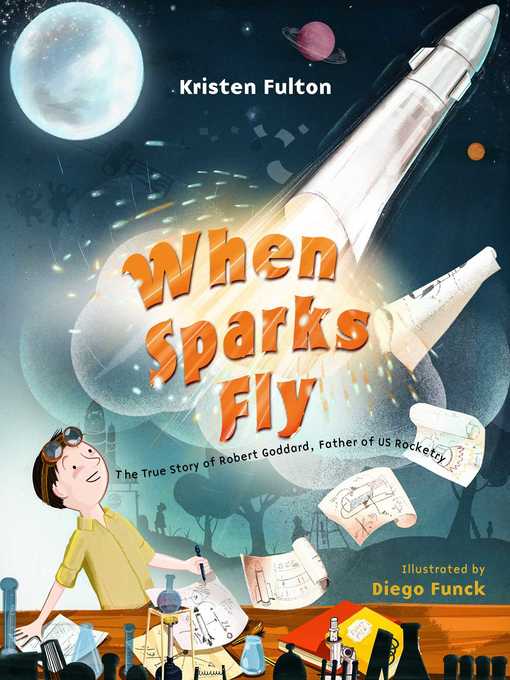
When Sparks Fly
The True Story of Robert Goddard, the Father of US Rocketry
فرمت کتاب
ebook
تاریخ انتشار
2018
Lexile Score
690
Reading Level
2-3
ATOS
3.9
Interest Level
K-3(LG)
نویسنده
Diego Funckشابک
9781481460996
کتاب های مرتبط
- اطلاعات
- نقد و بررسی
- دیدگاه کاربران
نقد و بررسی

April 15, 2018
Punctuated--unsurprisingly--by explosions, an account of the groundbreaking rocketeer's childhood and first experiments.Fueled by an early interest in hands-on science nurtured by his parents and sparked by reading The War of the Worlds, Goddard's ambition to "build something that would soar to space" led to years of experimentation and failure analysis. Finally, in 1926, a brief but successful flight pointed the way to "every shuttle that has blasted into space, every astronaut who has defied gravity, and every man who has walked on the moon." Fulton occasionally skimps on scientific details (in one childhood trial Robert "emptied a small vial of hydrogen into a pan"; even in the backmatter, there's no explanation why, as he notes in his journal, "Hydrogen and oxygen when combined near a flame will ignite"). Still, she highlights the profound curiosity and determined, methodical effort that ultimately earned her subject a well-deserved place in the pantheon of scientists and inventors. Scientific gear in Funck's cartoon illustrations often looks generic, and in one scene he depicts a rocket that is markedly different from the one described in the adjacent narrative. Moreover, his explosions look like fried eggs, and most come with oddly undersized if all-capped onomatopoeia ("BOOM!"; "POP!") that underplays both the melodramatic potential and the real danger to which Goddard must have exposed himself. Goddard and his family are white.Disappointingly lackadaisical. (afterword, list of sources) (Picture book/biography. 7-9)
COPYRIGHT(2018) Kirkus Reviews, ALL RIGHTS RESERVED.

June 1, 2018
Gr 2-4-Robert Goddard is a fairly unsung hero of science. Though he is widely acknowledged to be one of the founding fathers of rocketry, and though he filed 214 patented inventions related to rocketry, he found little support for his work during his lifetime, and he is not well known outside scientific circles. This modest picture book begins to correct that. A biography, the book chronicles Goddard's development from infancy through an awakening of interest in rockets, past many failures, and on to success. The narrative's strength is its focus on Goddard's insatiable curiosity, his determination, and the way in which his failures fed his eventual success in developing rockets. Funck's illustrations underscore the importance of Goddard's work, invoking a legendary feel. While the writing is clunky at times, and the author missed some opportunities (Goddard found inspiration while trimming the limbs of a cherry tree; he gained insights from watching birds), this simple account offers a reliable, child-friendly introduction to rocket science. VERDICT An inspiring true story punctuated with explosions that should be popular in most school libraries.-Sheri Reda, Wilmette Public Library, IL
Copyright 2018 School Library Journal, LLC Used with permission.

June 1, 2018
Grades K-2 This picture-book biography addresses Robert Goddard, born in 1882 and a self-taught scientist and early experimenter in rocketry. Telling details from his early life are used to predict his later achievements. His parents considered him too ill to attend school, but, wanting him to receive some kind of an education, gave him a boxful of science equipment and a subscription to Scientific American. He used materials at hand?including the oxygen tank he needed to assist his breathing?to literally fuel his earliest experiments. The text is straightforward and sequential, and is aptly complemented by the gouache-and-acrylic artwork. Without word clues, the illustrations show Goddard progressing from young boy to lanky teenager to mustachioed adult. The final pages list technological achievements directly influenced by Goddard's research: space shuttles, moon walks, torpedoes, bazookas, and even the Swissmetro (airless tunnels). A works cited page makes this useful for early research projects. This is an engaging and accessible contribution to the STEM-related biography canon.(Reprinted with permission of Booklist, copyright 2018, American Library Association.)

























دیدگاه کاربران